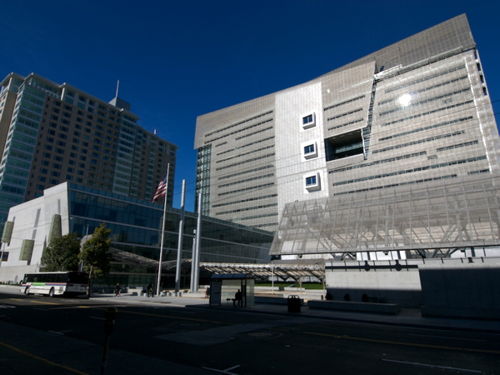Molybdenum: A Key Ingredient In Stainless Steel's Strength And Longevity
 |
|
Stainless steel has been used in many landmark structures, both old and new. Shown above are two new examples: the San Francisco Federal Building in San Francisco, CA (above) and the Friends Arena in Solna, Sweden. |  |
 |
|
Tim Outteridge, Secretary-General,
International Molybdenum Association (IMOA)
Molybdenum is extracted from the mineral molybdenite, discovered by Peter Jacob Hjelm in 1782. It remained a laboratory curiosity until the extraction of commercial quantities became practical. Today it is used in many industries including construction, where it is a key component in stainless steel..
Experiments after World War I demonstrated that molybdenum could effectively replace tungsten in many steel alloys and molybdenum became a widely accepted technical material by the end of the 1930s. The end of World War II in 1945 once again brought increased research investment to develop new civilian applications, and post-war reconstruction provided additional markets for molybdenum-containing structural steels.
Today, steels and cast iron comprise the single biggest market segment for molybdenum demand, yet molybdenum is also invaluable in superalloys, nickel-based alloys, lubricants, chemicals, electronics and many other applications.
A small amount of molybdenum can make a big difference to metal performance. When used as an alloying element, molybdenum can increase the strength of steels at normal and elevated temperatures, without sacrificing toughness. It also gives exceptional corrosion resistance to stainless steels and nickel alloys.
An important but hidden use of molybdenum-containing stainless steel is in reinforcing bars for concrete structures. The U.S. Federal Highway Administration commissioned corrosion testing in order to aid their selection of rebar materials capable of extending the life of reinforced concrete bridges to 75-100 years when the concrete was contaminated with chlorides. The study concluded that Type 316 molybdenum-containing stainless steel would be able to provide that required lifetime.
At the opposite end of the spectrum, architecture is perhaps the most visible of all of the applications of molybdenum-containing stainless steel. For nearly 100 years, stainless steel has been the material of choice for achieving great performance coupled with modern, progressive aesthetics. Already a very durable architectural material, when molybdenum is added, resistance to corrosion caused by chlorides (from coastal or deicing salts) and pollution is further increased. This makes molybdenum-containing stainless steels the ideal choice for buildings, bridges, transit facilities, urban furniture, sculptures and many other applications. Not only can it last for the design life of the structure, if properly selected, the appearance of an appropriate molybdenum-containing stainless steel and finish combination will remain virtually unchanged, minimizing maintenance requirements.
IMOA has developed selection guidelines for stainless steel based on the assumption that corrosion staining is aesthetically unacceptable. The Stainless Steel Evaluation System is designed for use by architects, contractors, and others involved in stainless steel selection and itemizes the factors that must be considered when choosing stainless steel for exterior applications using a simple scoring system. It consists of a software program and brochure outlining the system, case studies from around the world, and links to data needed to evaluate a site (pollution, corrosion maps, climate, etc.). The software, and a host of case studies featuring the use of molybdenum containing stainless steel in building applications, can be found online at IMOA’s website.
Examples of impressive molybdenum-containing stainless steel architecture can be found all over the world, from London’s One Canada Square to the Harbor Drive Bridge in San Diego and in many projects under construction including the new condominium building on West 57th St and the façade and spire of 1 World Trade Center in New York.
Molybdenum alloyed steel is also making considerable contributions to sustainable building in terms of energy efficiency and resource conservation. Air conditioning is the biggest single source of energy consumption in many modern buildings and sunscreens are increasingly specified to reduce passive solar heat gain. The Federal Building in San Francisco, CA, incorporates a sophisticated computer-controlled sunscreen made from molybdenum-containing Type 316 stainless steel. Combined with natural ventilation, this greatly reduces the need for air conditioning, cutting the building’s energy consumption by two-thirds. The molybdenum in the stainless steel significantly increases its resistance to corrosion from the urban coastal environment and therefore helps to guarantee a design life of 100 years.
The American Institute of Steel Construction (AISC) last year published Design Guide number 27 for structural stainless steel, fulfilling the need for U.S. design recommendations for larger stainless steel sections. Lighter gauge stainless steel sections were already covered by a US design specification, but no guidance existed for heavier sections, meaning that building enforcement officials had to individually approve each application. The new guide is written in the form of a specification, enabling designers to reference it as justification, eliminating a tremendous amount of work and creating new growth potential in applications like pedestrian bridges, buildings and other load-bearing structures.
Molybdenum makes a further contribution to more sustainable buildings through its role in the production of high-strength steel (HSS). While the yield strength of steel can be increased by adding more carbon, it can have a detrimental effect on both ductility and weldability. However, with the addition of molybdenum, increased yield strength is possible without compromising weldability. Adding molybdenum also maintains toughness and improves hardenability.
HSS enables stronger and lighter structures than conventional steel, thereby saving resources as well as cost and energy in production and transportation. Although CO2 emissions resulting from the production of HSS are slightly higher than those for conventional steel, the weight savings from using HSS are typically between 20% and 40%, leading to significant overall reductions in CO2 emissions.
Used in the construction of long-span structures, HSS can replace conventional steel, offering significant cost and environmental savings. The roof of the Friends Arena in Stockholm, Sweden, was constructed using HSS, with 750kg of molybdenum contained in the higher strength grades. Replacing conventional steel with HSS in selected parts of the roof reduced total steel consumption by 17% and total costs by 14.5%, whilst generating a 17% reduction in greenhouse gas emissions compared to conventional steel, over the lifecycle of the stadium.
For further information about molybdenum’s applications in design and build, please visit www.imoa.info, email info@imoa.info, or call +44 20 8747 6120.
About the IMOA
 The International Molybdenum Association is a non-profit trade association representing the interests of most of the world’s molybdenum producers and converters, as well as traders and end users. Molybdenum is added to steels and cast irons to improve strength, toughness, hardenability and weldability for numerous applications in the automotive, shipbuilding, construction, mining, chemical, oil & gas and energy generation industries. In stainless steels and superalloys, it improves corrosion resistance and high-temperature performance and finds uses in many industrial applications. It is also used in a variety of products from catalysts and lubricants to pigments and paint. To learn more, visit www.imoa.info.
The International Molybdenum Association is a non-profit trade association representing the interests of most of the world’s molybdenum producers and converters, as well as traders and end users. Molybdenum is added to steels and cast irons to improve strength, toughness, hardenability and weldability for numerous applications in the automotive, shipbuilding, construction, mining, chemical, oil & gas and energy generation industries. In stainless steels and superalloys, it improves corrosion resistance and high-temperature performance and finds uses in many industrial applications. It is also used in a variety of products from catalysts and lubricants to pigments and paint. To learn more, visit www.imoa.info.